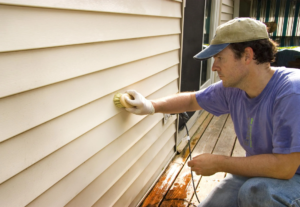Why Choose Vinyl Siding For Your Home?
The exterior of your home is the first impression visitors and passers-by have of your space. Whether you prefer a Marigold that brightens your block or a calming Coastal Blue, vinyl offers many shade and texture options to complement any style preference.
As homeowners, we already have a lot to keep up with: cleaning, mowing, scrubbing, painting and so on. With minimal upkeep and a long lifespan, vinyl siding is one of the most popular choices for house cladding. Click Learn More Here now!

Vinyl is a durable material, but the lifespan of this siding will depend on the climate and how well homeowners maintain it. For example, if a homeowner lives in a mild climate and immaculately cares for their vinyl, they may be able to expect it to last upwards of 40 years. On the other hand, if a homeowner living in an extreme climate neglects their vinyl, it could start to deteriorate much faster and need replacement sooner.
The longevity of vinyl siding is also influenced by the type of vinyl that is chosen. For instance, some manufacturers make a specific type of vinyl that is rated to withstand high winds and severe weather conditions. Other types of vinyl are better suited for homeowners who live in more moderate climates and want their siding to last longer.
One of the main reasons why vinyl is a popular siding option is because it requires very little maintenance. In fact, most of the time, a quick sweep with a brush or hose and some soap and water is all that this type of siding needs to stay looking beautiful. This minimal amount of maintenance makes it an appealing option for homeowners who want to spend less time on home upkeep and more time focusing on other areas of their life.
Vinyl is also a material that resists moisture and rot. This helps it to last longer than many other types of siding and can help to protect the interior of a house from rot and mold. This is why so many people choose vinyl over other siding options like wood.
However, vinyl is not completely indestructible. It can still be damaged by insects, severe weather, or other external factors. For example, if a tree or large piece of debris falls onto the house, it is possible that the vinyl will be cracked or dented.
Another issue with vinyl is that it can rust or corrode if it is exposed to salty air or ocean spray. This is why it is important to select a quality vinyl siding product that is designed for the climate of your home.
Low Maintenance
The siding on your home says a lot about it, and it is often the first thing that visitors and passers-by notice. That’s why it’s important to choose a material that looks great but is also low-maintenance to reduce the amount of time you spend cleaning and upkeep.
Vinyl siding has been billed as the perfect solution for homeowners who want to skip painting and maintain their homes’ exteriors with minimal effort. Designed to resist mold, mildew, and insect infestations, vinyl is a durable option that’s incredibly easy to clean and doesn’t require repainting.
This type of cladding is also water resistant, meaning that it will not rot or be damaged by the rain or sun’s UV rays. That makes it a good choice for people in regions with unpredictable weather patterns, or for those who live on the coast where storms are more frequent.
As a manmade product, vinyl doesn’t require the deforestation that other types of siding might rely on. It’s also much less likely to end up in a landfill, which is an additional plus for those who are conscious about their environment.
With minimal maintenance requirements, vinyl is a durable option that will continue to look great for decades. Most people only need to rinse it down with a hose and soapy water once or twice a year to keep it looking clean and free of dirt, debris, bugs and cobwebs.
Vinyl is also a good insulator, and can help to lower your utility costs by preventing the flow of heat through walls and into your home. By helping to regulate your home’s temperature, it can also extend the lifespan of your HVAC and other home systems.
While there are many benefits to choosing vinyl for your home, it’s important to find a contractor who will perform a high-quality installation. A quality installer will ensure that the vinyl is properly secured, which can help prevent any potential damage to the underlying structure of your house over the years. They can also make any necessary repairs to the underlying structure before installing new vinyl on top of it, which will give you peace of mind that your investment in vinyl will be worthwhile for years to come.
Variety of Colors
The beauty of vinyl siding is that it comes in a variety of colors to fit any style or decor. It’s important to choose a color that will complement your home’s exterior and blends well with the surrounding landscape. The right color can enhance your curb appeal and increase your home’s resale value.
When choosing a color, review inspirational photos of homes in your neighborhood and visit them in person to get an idea of what they look like in real life. If you are looking for a warm, rustic feel, consider brick red. It’s a timeless color that will stand the test of time. If you’re looking for something more muted, opt for a shade of green. It’s a natural and soothing hue that pairs well with many different architectural styles and materials.
In addition to the color, you should also consider the texture of the vinyl. The latest vinyl siding is designed to mimic the appearance of wood grain, giving it a more authentic look. It also has a better finish than the vinyl of even ten years ago. It doesn’t have the seams that were a major drawback of the product in the past, and it looks much more realistic.
It is important to hire a professional contractor to install your vinyl siding. The product expands and contracts significantly with temperature changes, so a poor installation job can lead to warping, cracking and mold. The best vinyl siding contractors are certified, insured and bonded. They should be able to provide you with references and proof of insurance so you can verify their work.
Vinyl siding is a popular choice for new construction because it’s inexpensive, durable and attractive. It’s a good alternative to clapboard and shingle siding, as it offers similar visual appeal without the high cost of wood. It is also easy to clean and maintain.
Some homeowners are concerned that vinyl will decrease the value of their historic homes, but there are many manufacturers that offer period patterns and details to match older houses. In addition, most historic neighborhoods have strict guidelines that require homeowners to maintain the integrity of the neighborhood. If your house needs updating, talk to your local preservation specialist before choosing vinyl siding.
Energy Efficiency
The insulating properties of vinyl help cut home energy costs by keeping the cold out in winter and the hot out in summer. Homes sided with vinyl are also more comfortable than those that are insulated with other materials such as aluminum or steel siding.
Vinyl is a slow conductor of heat, which means that it keeps exterior temperatures from transferring into a house. This is especially true of insulated vinyl, which contains a layer of foam insulation that helps reduce air loss and decreases a building’s overall energy usage.
Insulated vinyl can also reduce the risk of water leaks, which can damage a home’s structure. This is because it creates a tight seal that keeps moisture out, which can lead to rotting, mold growth, and other costly problems.
Another perk of vinyl siding is that it can reflect the sun’s UV rays, which can keep interior temperatures cooler and prevent overheating. In addition, vinyl is waterproof and helps to minimize humidity levels inside a home. This is particularly important during the summer, as high humidity can make a home feel warmer than it really is and cause air conditioning to run more frequently.
Many homeowners enjoy the versatility of vinyl siding, which comes in a variety of styles, textures, and colors to match the look of any dwelling. It can mimic the appearance of painted wood without all of the upkeep that wooden siding requires. For example, a homeowner can choose from clapboard, dutch lap, shakes and scallops to give their home a more traditional or modern look.
Vinyl is easy to install and does not require a primer, making it a cost-effective option for any home renovation. It also does not rot, rust or warp and is resistant to extreme weather conditions, including high winds and heavy rain. This helps to protect your home from the elements and preserve its value over time, making it a smart investment for any homeowner. It is important to note that vinyl does not perform well in extremely cold climates, however, as the planks may crack or break under expansion and contraction caused by varying temperatures.
